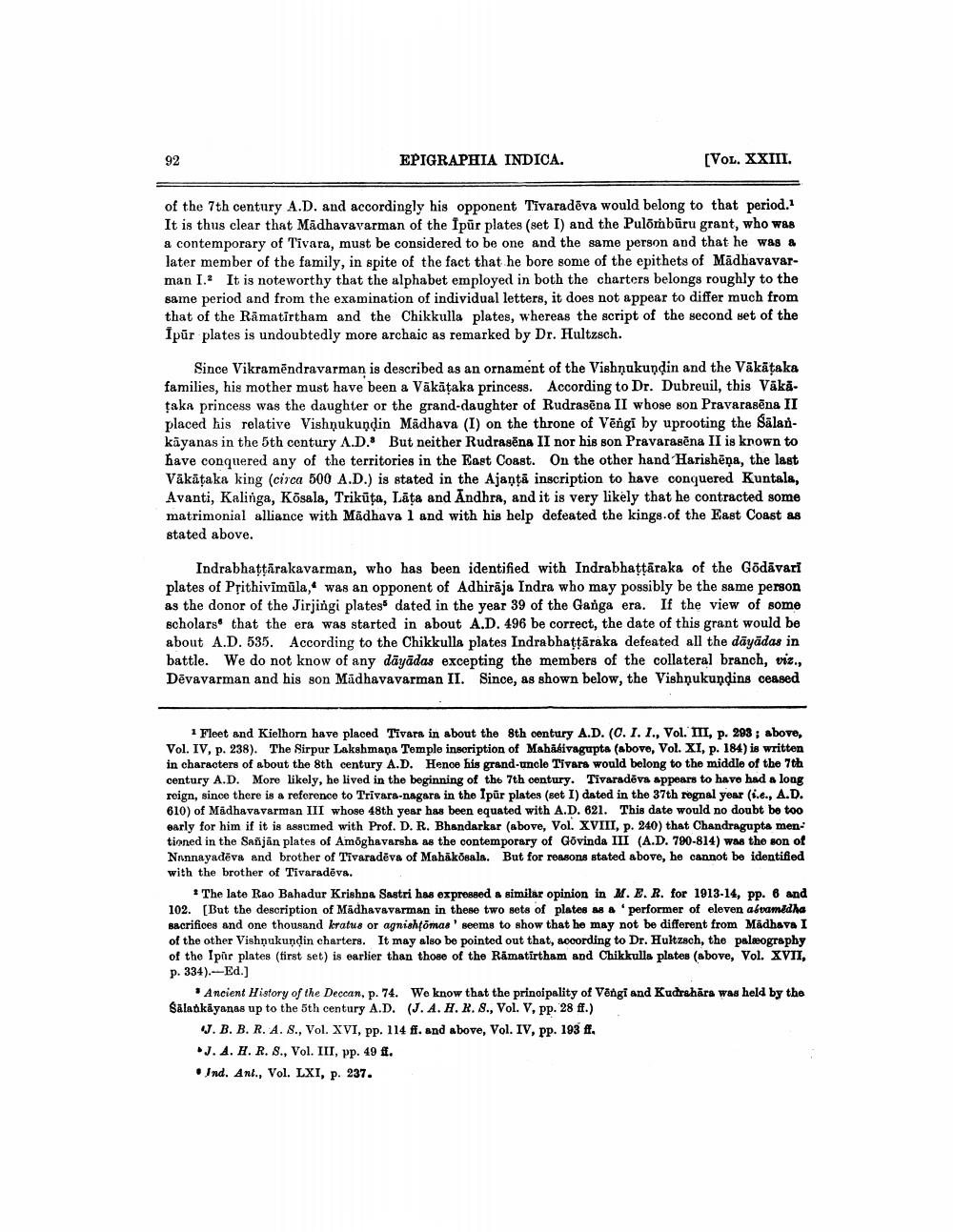________________
EPIGRAPHIA INDICA.
[VOL. XXIII.
of the 7th century A.D. and accordingly his opponent Tivaradeva would belong to that period. It is thus clear that Madhavavarman of the Ipūr plates (set I) and the Pulombūru grant, who was a contemporary of Tivara, must be considered to be one and the same person and that he was a later member of the family, in spite of the fact that he bore some of the epithets of Mādhavavarman I. It is noteworthy that the alphabet employed in both the charters belongs roughly to the same period and from the examination of individual letters, it does not appear to differ much from that of the Rāmatirtham and the Chikkulla plates, whereas the script of the second set of the Ipār plates is undoubtedly more archaic as remarked by Dr. Hultzsch.
Since Vikramēndravarman is described as an ornament of the Vishnukundin and the Vākātaka families, his mother must have been a Vākāțaka princess. According to Dr. Dubreuil, this Väki. taka princess was the daughter or the grand-daughter of Rudrasēna II whose son Pravarasēna II placed his relative Vishņukundin Madhava (I) on the throne of Vēngi by uprooting the Sālankāyanas in the 5th century A.D. But neither Rudrasēna II nor his son Pravarasēna II is known to have conquered any of the territories in the East Coast. On the other hand Harishēņa, the last Väkātaka king (circa 500 A.D.) is stated in the Ajanţă inscription to have conquered Kuntala, Avanti, Kalinga, Kösala, Trikūta, Lāta and Andhra, and it is very likely that he contracted some matrimonial alliance with Madhava l and with his help defeated the kings of the East Coast as stated above.
Indrabhattārakavarman, who has been identified with Indrabhattāraka of the Gödāvari plates of Pțithivimüla,' was an opponent of Adhirāja Indra who may possibly be the same person as the donor of the Jirjingi plates dated in the year 39 of the Ganga era. If the view of some scholars that the era was started in about A.D. 496 be correct, the date of this grant would be about A.D. 535. According to the Chikkulla plates Indrabhatýāraka defeated all the dāyādas in battle. We do not know of any dāyādas excepting the members of the collateral branch, viz., Dévavarman and his son Madhavavarman II. Since, as shown below, the Vishņukuņņins ceased
1 Fleet and Kielhorn have placed Tīvara in about the 8th century A.D. (0.1. I., Vol. III, p. 293 ; above, Vol. IV, p. 238). The Sirpur Lakshmana Temple inscription of Mahāśivagupta (above, Vol. XI, p. 184) is written in characters of about the 8th century A.D. Hence his grand-uncle Tivars would belong to the middle of the 7th century A.D. More likely, he lived in the beginning of the 7th century. Tivarados appears to have had a long reign, since there is a reference to Trivara-nagara in the Ipār plates (set I) dated in the 37th rognal year (i.e., A.D. 610) of Mādhavavarman III whose 48th year has been equated with A.D. 121. This date would no doubt be too early for him if it is assumed with Prof. D. R. Bhandarkar (above, Vol. XVIII, p. 240) that Chandragupta men. tioned in the Sañjān plates of Amõghavarsha as the contemporary of Govinda III (A.D. 790-814) was the son of Nannayadēva and brother of Tivaradēva of Mabākosala. But for reasons stated above, he cannot be identified with the brother of Tivaradēva.
* The late Rao Bahadur Krishna Sastri has expressed & similar opinion in M. E. R. for 1913-14, pp. 6 and 102. [But the description of Madhavavarman in these two sets of plates as a performer of eleven afvamedha sacrifices and one thousand kratus or agnishtömas' seems to show that he may not be different from Madhava I of the other Vishnukuņdin charters. It may also be pointed out that, according to Dr. Hultzach, the paleography of the Ipār plates (first set) is earlier than those of the Rāmatirtham and Chikkulla plates (above, Vol. XVII, p. 334).--Ed.]
Ancient History of the Deccan, p. 74. We know that the prinoipality of Vengi and Kudrahāra was held by the Saladkāyanas up to the 5th century A.D. (J. A. H. R. 8., Vol. V, pp. 28 ff.)
J. B. B. R. A. S., Vol. XVI, pp. 114 ff. and above, Vol. IV, pp. 193 ff.
J. A. H. R. S., Vol. III, pp. 49 f. • Ind. Ant., Vol. LXI, p. 237.




